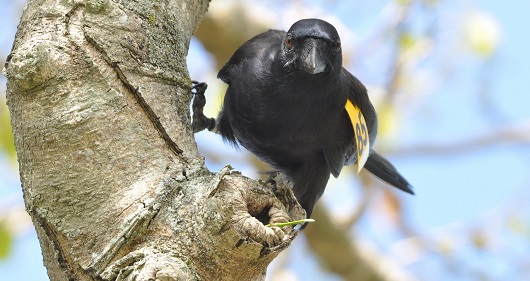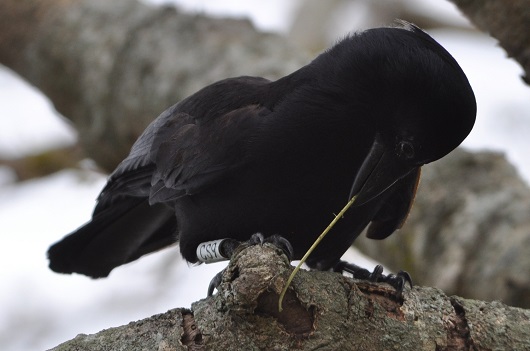Crows ‘hooked’ on fast food

Biologists at the Universities of St Andrews and Edinburgh have discovered why some crows ‘craft’ elaborate hooked tools out of branched twigs.
The new study, published in Nature Ecology & Evolution today (22 January), explores why crows go the extra mile rather than using simple, unmodified sticks to extract prey – it allows them to get at hidden food several times faster than if they used basic (non-hooked) tools.
New Caledonian crows are famous for their use of tools to winkle beetle grubs and other small prey out of hiding places. Although crows are capable of extracting food with straight twigs, in some areas they actively manufacture hooked stick tools before going hunting.
“It’s a painstaking sequence of behaviours,” explains lead author Dr James St Clair, from the School of Biology, University of St Andrews. “Crows seek out particular plant species, harvest a forked twig, and then – firmly holding it underfoot – carve, nibble and peel its tip, until it has a neat little hook.”
Biologists have long assumed that there was some benefit to crows manufacturing hooked tools, but had no idea just how much better they might be. The Scottish team conducted experiments to record how long wild-caught crows took to extract food from a range of naturalistic tasks, using either hooked or non-hooked tool designs.

Depending on the task, they found that hooked tools were between two and ten times more efficient than non-hooked tools. “That’s a huge difference!” says project leader, Professor Christian Rutz from the University of St Andrews. “Our results highlight that even relatively small changes to tool designs can significantly boost foraging performance.”
These new findings help explain why New Caledonian crows have evolved such remarkable tool-making abilities: “In nature, getting food quickly means that birds have more time and energy for reproduction and steering clear of predators. It’s really exciting that we were able to measure the benefits of these nifty crow tools,” adds study co-author Professor Nick Colegrave from the University of Edinburgh’s School of Biological Sciences.
Scientists still don’t know how crows acquire the ‘know-how’ and make hooks; they may inherit the ability from their parents, or learn by observing experienced birds. Either way, because hooked-tool users will live longer and leave more offspring, the skill is expected to spread.
Professor Rutz notes wryly: “We’ve all heard that the early bird gets the worm. In the case of the New Caledonian crow, it’s the skilled hook-maker that gets the worm, or at least it gets many more worms than its less-crafty neighbours!”
NOTES TO NEWS EDITORS/PICTURE DESKS
The paper ‘Hook innovation boosts foraging efficiency in tool-using crows’ is published in the journal Nature Ecology & Evolution (22 January); available here.
Please ensure that the paper’s DOI (http://dx.doi.org/10.1038/s41559-017-0429-7) is included in all online stories and social media posts, and that Nature Ecology & Evolution is credited as the source; the link will become active once the embargo has lifted.
Photos and videos of tool-using crows are available here, with credits indicated in the file names.
New Caledonian crows live on the remote tropical island of New Caledonia in the South Pacific, where the St Andrews team conducted fieldwork for the present study. Birds were kept in field aviaries for the brief duration of behavioural experiments, before being released back into the wild, so they could re-join their social groups.
Professor Nick Colegrave from the University of Edinburgh led the statistical analyses. The researchers used specialised techniques to estimate how long prey ‘survived’ under crow attack, providing a measure of tool efficiency.
In a recent paper in Current Biology published in December 2017 (available here), the St Andrews team reported that the foraging efficiency of hooked tools increases with the depth of the hook.
Last year, the St Andrews team reported in Nature (see here) that a second tropical crow species – the critically-endangered Hawaiian crow – is a highly-skilled tool user. It is not yet known whether Hawaiian crows also make hooked foraging tools.
The St Andrews team exhibited its crow research at the 2017 Royal Society Summer Science Exhibition in London; a promotional YouTube video explaining the significance of the research is available here.
Forbes magazine recently selected the fish hook as one of the most important tools of all time, as reported here.
The study was funded by the UK’s Biotechnology and Biological Sciences Research Council (BBSRC).
INTERVIEW REQUESTS
Dr James St Clair ([email protected]) and Professor Christian Rutz ([email protected]) are available for interview, and can be contacted via the University of St Andrews Communications Office, contact details below.
Professor Nick Colegrave can be contacted via the University of Edinburgh Press Office, contact Catriona Kelly on 0131 651 4401 or [email protected].
St Andrews has an in-house ISDN line for radio and a Globelynx camera for TV interviews, which can be booked through the University of St Andrews Communications Office.
Issued by the University of St Andrews Communications Office, contact Christine Tudhope on 01334 467 320 / 07526 624 243 or [email protected].
Category Research